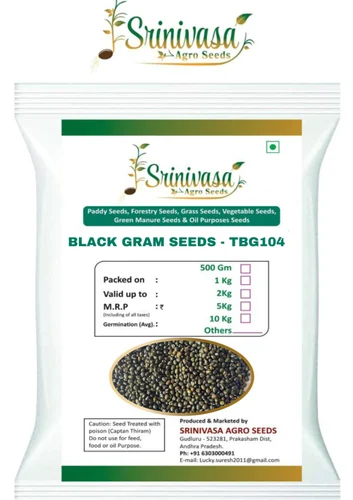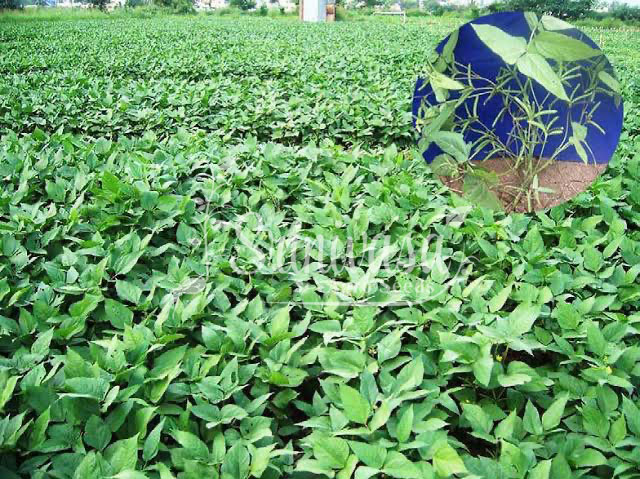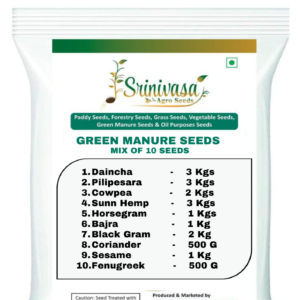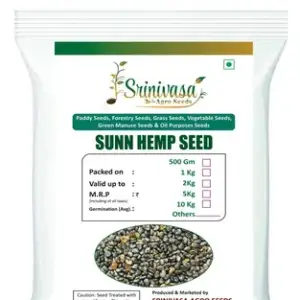Description
1. FIELD PREPARATION
- Prepare the land to fine tilth and form beds and channels.
- Amendments for soil surface crusting: To tide over the soil surface crusting apply lime at the rate of 2t /ha along with FYM at 12.5 t/ha or composted coirpith at 12.5 t/ha to get an additional yield of about 15 – 20%.
SEED RATE
10 KG Per Acre
2. SEED TREATMENT
Treat the seeds with Carbendazim or Thiram @ 2 g/kg of seed 24 hours before sowing (or) with talc formulation of Trichoderma viride @ 4g/kg of seed (or) Pseudomonas fluorescens @ 10 g/kg seed. Bio control agents are compatible with biofertilizers. First treat the seeds with Biocontrol agents and then with Rhizobium. Fungicides and biocontrol agents are incompatible.
Note: Seed treatment will protect the seedlings from seed borne pathogens, root-rot and seedlings diseases.
3. SEED TREATMENT WITH BIOFERTILIZER
Treat the seeds with 3 packets (600 g/ha) of Rhizobial culture CRU-7 + 3 packets (600 g/ha) of PGPR and 3 packets(600 g/ha) of Phosphobacteria developed at TNAU using rice kanji as binder. If the seed treatment is not carried out apply 10packets of Rhizobium (2000 g/ha) + 10 packets of PGPR (2000 g/ha) and 10 packets (2000 g) of Phosphobacteria with 25 kg of FYM and 25 kg of soil before sowing.
4. FERTILIZER APPLICATION
- Apply fertilizers basally before sowing.
Rainfed : 12.5 kg N + 25 kg P2O5 + 12.5 kg K2O +10 kg S*/ha
Irrigated : 25 kg N + 50 kg P2O5 + 25 kg K2O + 20 kg S*/ha
*Note : Applied in the form of gypsum if Single Super Phospate is not applied as a source of phosphorus
- Soil application of 25 kg ZnSo4/ha under irrigated condition
- Soil application of TNAU micronutrient mixture @ 5 kg/ha as Enriched FYM (Prepare enriched FYM at 1:10 ratio of MN mixture & FYM ; mix at friable moisture &incubate for one month in shade).
Foliar spray of 1% urea for yield improvement in black gram
For yield improvement through increasing the physiological, biochemical attributes, foliar spray of urea 1% on 30 and 45 days after sowing is recommended. For rice fallow pulses in Delta area, the present recommendation of foliar spray of 2% DAP may be continued.
Foliar spraying to mitigate moisture stress
Foliar spraying of 2% KCl + 100 ppm Boron during dry spell as mid season management practice in black gram during Rabi season is recommended to increase the yield over KCl spray alone .
Economizing the use of micronutrients through seed treatment for blackgram
Seed coating with biofertilizers and micronutrients viz., Zn, Mo & Co @ 4, 1, 0.5 g/kg of seed is recommended.
Nitrogen substitution by organic sources for pulses
50 per cent nitrogen can be substituted through organic source (850 kg of vermicompost per hectare). Lime application is recommended for pulses with soil pH less than 6.0.
5. SOWING OF SEEDS
- For irrigated crop dibble the seeds adopting 30 x 10 cm cm spacing
- For rainfed crop dibble the seeds adopting 25 cm x 10 cm spacing
6. WATER MANAGEMENT
Irrigate immediately after sowing, followed by life irrigation on the third day. Irrigate at intervals of 7to 10 days depending upon soil and climatic conditions. Flowering and pod formation stages are critical periods when irrigation is a must. Avoid water stagnation at all stages. Apply KCl at 0.5 per cent as foliar spray during vegetative stage if there is moisture stress.
7. SPRAYING OF DIAMMONIUM PHOSPHATE OR UREA, NAA AND SALICYLIC ACID
a. Foliar spray of Spray of NAA 40 mg/lt and Salicylic acid 100 mg/lt once at pre-flowering and another at 15 days thereafter
b. i) For rice fallow crops foliar spray of DAP 20 g/lt once at flowering and another at 15 days thereafter
ii) For irrigated and rainfed crops, foliar spray of DAP 20 g/litre or Urea 20 g/litre once at flowering
and another at 15 days thereafter.
c. Foliar spray of salicylic acid 100 mg/litre once at preflowering and another at 15 days there after.
8. WEED MANAGEMENT
- Pre emergence application of Pendimethalin 3.3 litres/ha under irrigated condition 2.5 litres/ha under rainfed condition on 3 days after sowing using Backpack/ Knapsack/Rocker sprayer fitted with flat fan nozzle using 500 litres of water for spraying one ha followed by one hand weeding at 20 DAS (or) EPOE application of quizalofop ethyl @ 50 g ai/ha-1 and imazethapyr @ 50 g ai ha-1 on 15 – 20 DAS. If herbicides are not applied give two hand weedings on 15 and 30 days after sowing.
- For the irrigated blackgram PE isoprotwron @ 0.5 kg ha-1 followed by one hand weeding on 30 DAS.
9. Multi bloom technology
A special technology being practiced in Pattukottai block of Tanjore district for blackgram and greengram. The soil is alluvial and rich in organic matter and nutrients. The crop is sown during early summer (Jan.-Feb.) as normal crop and fertilizer is applied as per the recommendation for irrigated crop. In addition to that, top dressing of Nitrogen is done with an extra dose of 25 to 30 kg through urea. Since pulses are indeterminate growth habit and continue to produce new flashes the top dressing will be done on 40-45 days after sowing. The crop complete its first flesh of matured pods during 60-65th day, further their second new flesh within 20-25 days. Therefore two fleshes of pods can be harvested at a time within the duration of 100 days.
1.TIME OF SOWING
Third week of January –Second week of February
2.SOWING OF SEEDS
- For relay cropping broadcast the seeds in the standing crop 5 to 10 days before the harvest of the paddy crop uniformly under optimum soil moisture conditions so that the seeds should get embedded in the waxy mire.
- For combined harvesting areas, broadcast the seeds before harvesting the paddy crop with machinery
3. SPRAYING OF DIAMMONIUM PHOSPHATE , NAA AND SALICYLIC ACID
- Foliar Spray of NAA 40 mg/lt and Salicylic acid 100 mg/lt once at pre-flowering and another at 15 days thereafter
- Foliar spray of DAP 20 g/lt once at flowering and another at 15 days thereafter
- Foliar spary of salicylic acid 100 mg/litre once at prefloweing in another and 15 days there after.
4. HARVESTING
- Picking the matured pods, drying and processing
- Uprooting or cutting the whole plants ,heaping ,drying and processing











Reviews
There are no reviews yet.